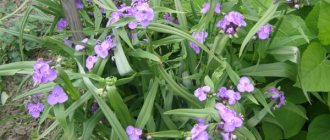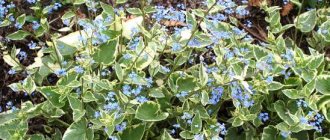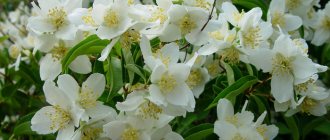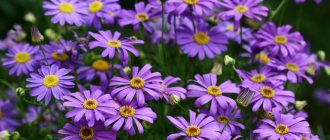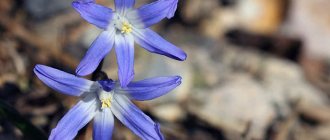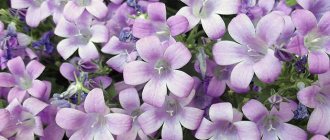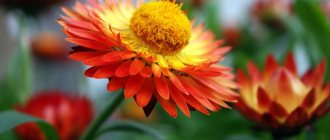The fashion for exotic plants, with non-standard shapes and lines, affects not only landscape design, but also the world of indoor plants. Today on store shelves you can find a huge number of modern ones, with daring lines and unusual “prickly” inflorescences of crops. One of these is exotic turmeric. In a plant with luxurious inflorescences formed by pink, white or purple apical leaves, everything seems original. And at first glance it’s hard to believe that this is the same plant from which the famous bright yellow spice is extracted. Indoor turmeric is a capricious crop that requires digging up for the winter. But it can become the real pride of the collection and a unique interior decoration.
Flowers of Turmeric altisfolia. © Pretty Kate Machine
Potted turmeric is more than just exotic
Turmeric in indoor cultivation is a relative of the plants from which the legendary saffron substitute is obtained in India. This is an exotic plant in every sense that can compete in showiness and style even with the recognized favorites of greenhouse floriculture. The Siamese Tulip is impressive, with amazing symmetrical lines, as if it embodies all the beauty of Indian flora.
The secret to the success of turmeric in indoor culture is the perfection of shapes and lines, bright individuality and non-standard flowering. But turmeric does not retain its beauty all year round: the above-ground parts of this plant completely die off during the winter and it must be stored outside the soil. In this, all types of indoor turmeric are very similar to corms and bulbous ones.
Among the numerous types of turmeric in indoor culture, the two most common are turmeric altisfolia and cedoaria .
Exotic turmeric cedoaria , also known among amateur flower growers as citvar root, is an exotic and very impressive plant. It evokes universal admiration during the flowering period. But in fact, it is not the flowers of the plant that are beautiful, but the apical leaves on the shoots. They form a false inflorescence, hugging the shoot like petals and creating a funnel-shaped inflorescence at the tops of the shoots, partially reminiscent of lotus flowers. The bracts are arranged in a spiral, which only adds to the charm of turmeric.
Up to 7 inflorescences bloom on one plant. The shape of the apical leaves is modified, they are beautifully pointed and petal-shaped, and the color is luminous, often almost porcelain and very bright.
Flowers of Turmeric cedoaria. © ogrodkroton
Traditionally, turmeric cedoaria is colored acrylic pink, but on sale you can also find various colors of the white-pink-violet spectrum. The only thing that remains constant is the purity of tone. In indoor cultivation, this turmeric will reach a height of 20-50 cm. Its leaves are lanceolate, spear-shaped, long, grow straight, wider than those of other species, and beautifully curved at the ends.
Common turmeric - the tallest of the indoor species is popularly called the Siamese tulip. It develops in the form of a more elegant, slender, unusual bush, whose leaves grow from rhizomes. Straight, lanceolate, they seem quite rigid, painted in a cool dark green color. The height of common turmeric reaches 40-80 cm.
Its flowering pattern repeats the characteristics of Cedoaria: at the top of the straight peduncles, bracts, or apical leaves, are arranged in a regular order, which hide inconspicuous white flowers. These pink, white, fuchsia “petals” are what give turmeric its exotic beauty. The lines and structure of the inflorescences surprisingly elegantly echo the leaves, the whole plant seems modern and non-standard.
In addition to these two types, both domestic turmeric and Sumatran turmeric are also found on sale. All representatives of the genus are similar to each other both in terms of growing conditions and in appearance. The difference is only in the shape of the bushes and leaves, but it is also insignificant.
The flowering period of turmeric traditionally covers summer, lasting from June to the end of September.
The flowers of Turmeric altisfolia are also called Siamese tulip. © On.My.BigfOot
Beneficial features
The beneficial properties of turmeric have been known since ancient times. In Hindustan, this valuable spice was used to cleanse the body. According to research, it stabilizes blood pressure and thins the blood [4]. In addition, the spice helps lower blood sugar levels and has a positive effect on the body's cardiovascular system. The substance curcumin improves the functioning of the gastrointestinal tract (GIT), restores the menstrual cycle, regulates cholesterol levels in the blood and helps with appetite disorders.
The plant has a beneficial effect on metabolism, eliminates irritation, dermatitis and allergies. Thanks to the essential oils included in the spice, liver function improves. There is a widespread belief among people that turmeric can heal better than antibiotics, without harm to the gastrointestinal tract. This spice is an excellent preventative against senile dementia (Alzheimer's disease) [5]. The plant effectively helps during rehabilitation after serious illnesses, supporting the body and cleansing the blood. For people suffering from obesity and diabetes, it is also recommended to include turmeric in their diet. By regularly adding 0.5 teaspoon of this spice to food, the condition of those suffering from arthritis improves after a certain time. The spice is actively used to prevent cancer and prevent the development of tumors.
Many women use the plant for cosmetic purposes and also for weight loss. Curcumin, as one of the spice components, effectively fights the formation of fatty tissue. Thanks to the regulation of metabolism, excess weight is actively lost. If you systematically add this spice to your food, your body will burn more calories and remove excess water. The plant oil is effectively used in aromatherapy as an antibacterial agent.
Turmeric development cycle similar to bulbs
Turmeric develops in cycles. After flowering is completed, the leaves of the plant wither in September-October. And this is the main signal for turmeric to enter a period of rest. At this time, you need to adjust the care, stop feeding and reduce the humidity of the substrate. After the leaves have completely died off, turmeric must be removed and the rhizome must be stored outside the soil during the entire dormant stage. Turmeric will not come out of it on its own and you cannot expect any signs of growth of this plant.
To achieve the beginning of the active phase of the growing season, it is necessary to independently stimulate the development of the buds. To do this, in the third ten days of February or the first ten days of March, the rhizomes need to be planted in a new substrate, transferred to warmth and light, and meager watering should begin. Turmeric wakes up slowly, but then begins to develop very actively. Only then is she transferred to standard care.
Turmeric first develops peduncles and flowers, and then leaves appear. But due to the fact that the inflorescences last for several months, the plant will be attractive until mid-autumn. As a result, throughout the warm season, turmeric serves as a luxurious accent in the interior.
Lighting for turmeric in indoor culture
Turmeric is a plant that is very demanding on lighting. But only according to one parameter - protection from direct sunlight. A direct, sunny location should not be allowed, but any diffuse lighting from light partial shade to a bright location is quite suitable for this exotic beauty. It’s easy to choose lighting: the plant itself signals by the lighter color of the leaves and bracts that it is better to move the pot to a lighter place. If turmeric is attractively bright, it means it is comfortable.
The dug up rhizomes of the plant are stored in complete darkness in winter: access to light to the roots at the stage of complete dormancy can be destructive.
Turmeric zedoaria, Zedoaria root, Zedoaria, Turmeric zedoaria, White turmeric (Curcuma zedoaria). © spaldingbulb
Temperature conditions for indoor turmeric
According to its Indian origin, indoor turmeric inherits from the base species a pronounced heat-loving nature. This indoor culture does not like coolness (even short-term). The air temperature in the room where turmeric grows should not fall below 20 degrees. But the plant cannot tolerate too much heat, becoming more demanding of air humidity. Try to keep your turmeric growing in stable temperatures of 20 to 22 degrees Celsius or slightly higher.
During the complete dormant stage, after removing the rhizome from the soil, turmeric should be kept within a temperature range of 15 to 18 degrees. Specify the specific temperatures at which you need to store dug out rhizomes when purchasing: depending on the type, turmeric can be stored both at standard temperatures and in much cooler conditions - from 7 to 9 degrees. Ask what kind of wintering your beauty will need.
In summer, actively growing and flowering turmeric can be exposed to the open air: it will not even be afraid of being taken out into the garden.
Watering turmeric abundantly and being smart about hydration
Maintaining high humidity is critical to success in growing turmeric. The plant needs it only at the stage of active development, while both humidifiers and regular spraying can be used to maintain high performance. The bracts and flowers of turmeric are not afraid of getting wet, so even at the flowering stage it will not refuse water treatments. The more often you can spray the plant, the better.
Watering for turmeric is also specific. She is afraid of waterlogging and acidification of the soil. But at the same time, this Indian culture needs stable, fairly high substrate humidity. Between procedures, only the top centimeters of the soil should dry out completely, but it is better to maintain uniform, constant moisture. From the moment turmeric is planted in the substrate and before preparations for digging begin, the soil should not be allowed to dry out completely: even a short drought will be disastrous for turmeric.
Transitions to complete rest and return to the active development phase should be smooth. Watering is reduced and resumed gradually. The longer you extend the reduction in watering, the better the turmeric will prepare for winter.
Common turmeric (Curcuma alismatifolia). © Ray
Treatment
Turmeric is widely used for medicinal purposes as it is an excellent natural antibiotic. For skin diseases it is used as follows [6]:
- dilute turmeric powder in a glass of boiled water and stir until a homogeneous thick mass is obtained;
- applied to affected areas of facial skin;
- Wash off with warm water until skin irritation and redness appears.
The resulting mixture effectively helps with furunculosis, eczema, itching and the presence of blackheads and pimples.
Turmeric has a healing effect on burns. To prepare the medicine, use a spice paste based on boiled water with the addition of aloe juice. The resulting product has a soothing effect on damaged skin.
The plant is also effective in helping with gum disease. For rinsing, use a solution of boiled water and one teaspoon of spice. When the procedure is carried out regularly, the inflammatory process is relieved and the gums are strengthened.
When treating colds, the spice is added to boiled milk and taken at least four times a day. Aromatherapy based on burnt spice helps get rid of a runny nose.
The spice of the fair sex was appreciated for its ability to influence breast size. Not without reason it is believed that this is a women's spice. In folk medicine, there is a healing drink with turmeric to increase breast size. To prepare it, you need to pour one level teaspoon of spice with warm raw milk. The resulting drink should be drunk before meals (preferably in the evening) for 31 days. To get a good result, you must adhere to several rules in parallel:
- exercise regularly;
- do not take a hot bath;
- don't slouch;
- wear the right bra;
- refuse a diet with a quick effect.
The spice perfectly helps restore the strength of damaged and brittle hair. To do this, you need to prepare a balm using the following ingredients:
- half a banana;
- turmeric;
- juice of two oranges;
- Applesauce from half an apple.
Grind the ingredients in a blender and apply the resulting mixture to washed, damp hair for 30 minutes, wrapping your head in a towel. After this procedure, wash your hair in warm water.
A unique remedy for many diseases is obtained by combining spices and honey. This mixture is used in the treatment of problematic facial skin. Combining the spice with milk and honey helps improve the structure of hair and nails. To do this, you need to drink a glass of milk with honey and turmeric every day.
Digging up rhizomes
After the leaves on the plant completely wither and the above-ground parts die off, the turmeric rhizome must be removed from the soil. It is carefully removed from the soil, the substrate is removed manually, trying not to damage even the slightest shoots of the roots. After this, the rhizome is allowed to dry at the usual temperatures for several days and is immediately removed for dark and cool storage until spring. You can store rhizomes in paper bags or wooden boxes, or in dry sand. If you were advised to keep turmeric after digging at a temperature below 10 degrees Celsius, then it is better to immerse the rhizome in sand.
Many gardeners who want to make growing easier do not dig the tubers out of the soil. But since in the spring they will still have to be transferred to a new substrate, and the rhizomes in a dry substrate in a pot will still need to be placed in a cool place, it is better to dig up the tubers right away.
Tubers of Turmeric tsedoaria, or tsitvarna, also Zedoaria. © Thamizhparithi Maari
How to care for a plant at home
We have discussed when to plant turmeric seeds. But in order for the plant to feel good at home and delight you with a rich harvest and beautiful flowering, it needs special care.
How to care for turmeric after sowing:
- create a temperature regime that will not drop by less than twenty degrees and rise above thirty-five degrees, otherwise the plant may rot or dry out;
- water and moisten the soil so that the top layer is always moist, but not wet, otherwise the roots may rot;
- spray twice a day with settled and warm water;
- Fertilize the soil once a month, and if the plant is weak, then twice.
Turmeric is a plant that is rarely eaten by any harmful insects, and it gets sick. But if you don’t take care of it properly, then it can also be affected by parasites that need to be fought.
If a thin web appears on the bottom of the leaves, then the spider mite has found a habitat. In this case, you need to give the bush a warm shower, but before that, wash all the leaves and stem down to the root with soapy water.
Cover the wet plant with film and create a greenhouse effect. Protect from direct sunlight.
If root rot appears, begin treatment immediately. To do this, cut off all affected parts and destroy them. Treat the places where the cuts were made with wood ash. Transplant the plant into another soil.
Planting turmeric in pots
At the end of winter and the very beginning of spring, turmeric needs to be “awakened”. The rhizomes are taken out into the warmth and immediately planted in pots with fresh substrate. Immediately after planting, the first watering is carried out, then the soil moisture is maintained at a minimum, but the plant is still not transferred to abundant moisture. At the first stage after planting, turmeric is transferred to a comfortable warmth and light. Active care is resumed only after the plant begins to actively grow. Frequent watering should be resumed gradually. Fertilizers are introduced a month after planting.
Pots for turmeric are selected according to the size of the rhizome: they should be several centimeters larger than the volume of the rhizome, not too spacious.
Substrate : for turmeric, the main soil parameters are looseness, water permeability, and light texture. This indoor plant prefers soils made from equal parts of humus, leaf, turf and peat soil, with a small admixture of river sand. In terms of acidity, it is better to choose slightly acidic substrates for turmeric. When grown for cutting, turmeric is often planted in a more unusual substrate - a mixture of 1 part coarse sand with 2 parts compost.
Turmeric propagation methods
This plant can only be propagated by dividing the rhizome - turmeric does not bear fruit in indoor cultivation. Dividing can be done on any adult plant before planting in the substrate. The divisions should be large; you should not divide the rhizome into more than 3 parts. In this case, at least 1 bud and 2-3 lateral roots should remain in each division. The separation is carried out with a sharp knife, the sections must be treated with crushed coal.
Turmeric altisfolia, or Siamese tulip
Contraindications and side effects
Turmeric is a potent spice and it is recommended that you consult a doctor before taking it. Excessive consumption of spices can cause diarrhea.
It is not recommended for people suffering from diabetes and low blood pressure to self-medicate by consuming spices without consulting a doctor.
The use of turmeric is contraindicated in the following cases [10]:
- the presence of stones in the gall bladder;
- hepatitis;
- pregnancy (uterine tone increases);
- spice allergy.
The recommended daily intake of spice is 1–3 g (level teaspoon) [11].
Best materials of the month
- Coronaviruses: SARS-CoV-2 (COVID-19)
- Antibiotics for the prevention and treatment of COVID-19: how effective are they?
- The most common "office" diseases
- Does vodka kill coronavirus?
- How to stay alive on our roads?


